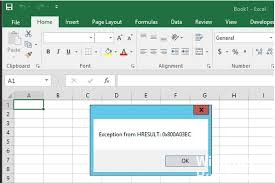5 Ways to Fix Exception Errors

Exception errors are an inevitable part of software development, often causing frustration and disrupting the smooth flow of a program. These errors occur when unexpected issues arise during runtime, leading to program crashes or unexpected behavior. In this article, we will delve into the world of exception handling and explore five effective strategies to tackle these errors, ensuring your software applications remain robust and resilient.
Understanding Exception Errors

Exception errors, also known as exceptions, are triggered when an unexpected condition or error occurs during the execution of a program. These errors can be caused by a variety of factors, including incorrect user input, file system issues, network problems, or even programming logic errors. The purpose of exception handling is to identify and manage these exceptions gracefully, preventing the entire program from crashing and ensuring user-friendly error messages and recovery mechanisms.
5 Strategies to Fix Exception Errors

Here are five proven strategies to handle and resolve exception errors effectively:
1. Catch and Handle Exceptions
One of the fundamental techniques to deal with exception errors is to catch and handle them within your code. By using try-catch blocks, you can identify specific exceptions and take appropriate actions. For example, if a division by zero error occurs, you can catch the exception, provide a meaningful error message to the user, and suggest alternative actions.
Here's an example of catching and handling an exception in Python:
try:
result = 10 / 0
except ZeroDivisionError:
print("Error: Division by zero is not allowed.")
print("Please provide a valid divisor.")
By implementing catch and handle mechanisms, you can ensure that your program continues to run smoothly even in the face of unexpected exceptions.
2. Implement Exception Hierarchy
Different programming languages provide an exception hierarchy, allowing you to handle exceptions at different levels of specificity. By utilizing this hierarchy, you can customize your exception handling based on the type of exception encountered. This approach enables you to provide more precise error messages and tailored recovery mechanisms.
For instance, in Java, you can catch a NumberFormatException and handle it separately from a NullPointerException, ensuring a more accurate response to each exception.
3. Use Exception Propagation
Exception propagation is a powerful technique that allows exceptions to bubble up the call stack until they are caught and handled. This approach ensures that exceptions are not silently ignored but are instead propagated to the appropriate level of the program, making it easier to identify and resolve the issue.
Consider the following example in JavaScript:
function divide(a, b) {
if (b === 0) {
throw new Error("Division by zero is not allowed.");
}
return a / b;
}
try {
const result = divide(10, 0);
console.log(result);
} catch (error) {
console.error(error.message);
}
In this case, the exception is thrown within the divide function and propagates up to the catch block, where it is handled gracefully.
4. Provide Custom Error Messages
Offering custom error messages is an essential aspect of exception handling. Instead of displaying generic error messages, you can create meaningful and user-friendly messages that provide valuable information to the user. These messages should guide the user toward a solution or suggest an alternative action to take.
For example, if a file read error occurs, you can display a message like, "Error reading file. Please check the file path and ensure the file exists."
5. Log Exceptions for Debugging
Logging exceptions is a crucial practice for debugging and troubleshooting purposes. By recording exception details, such as the exception type, error message, and stack trace, you can gain valuable insights into the root cause of the issue. These logs can be extremely helpful when analyzing and resolving complex exception errors.
In many programming languages, you can utilize logging libraries or frameworks to automatically capture and record exception details. These logs can be reviewed later to identify patterns, improve error handling, and enhance the overall stability of your software.
Conclusion
Exception errors are an inherent part of software development, but with the right strategies, they can be effectively managed and resolved. By implementing catch and handle mechanisms, utilizing exception hierarchies, propagating exceptions, providing custom error messages, and logging exceptions, you can create robust and resilient software applications. Remember, exception handling is an essential skill for every developer, ensuring a seamless user experience and a more reliable software ecosystem.
FAQ
What is the purpose of exception handling in programming?
+
Exception handling is a programming technique used to manage and recover from unexpected errors or exceptions that occur during runtime. Its primary purpose is to ensure the program continues to function smoothly, even in the face of errors, by providing appropriate error messages, recovery mechanisms, and graceful degradation.
Can exception handling prevent all errors from occurring?
+
While exception handling is a powerful tool for managing errors, it cannot prevent all errors from occurring. Some errors are inherent to the nature of programming and may arise due to incorrect user input, hardware failures, or other unforeseen circumstances. However, effective exception handling can minimize the impact of these errors and provide a better user experience.
What are some common causes of exception errors in software development?
+
Exception errors can be caused by a variety of factors, including incorrect user input, file system issues, network problems, memory allocation errors, division by zero, and even programming logic errors. These errors often arise due to unexpected conditions or inputs that the program was not designed to handle.



